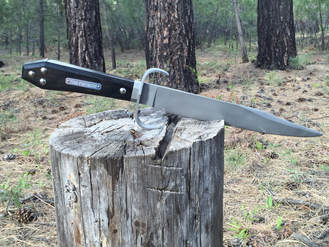
Among Bowie knife enthusiasts, the name Bill Bagwell is uttered with a hushed reverence. Bagwell is custom knifemaker in Texas who specializes in building large fighting bowie knives from scratch. If one wants a bowie, especially a fighting bowie, and one wants the best money can buy, they call Bill Bagwell.
His most famous bowie is called the “Helles Belle,” and it’s a beauty. Generally, it runs 11 -12” long in the blade, with a Spanish Notch, forward curved crossguard and a classic coffin-shaped handle. If you order one from Bagwell, he will want to know a variety of things about you, including height and weight, and will ask for a tracing of your hand. This will be your knife.
My Bagwell is not a custom job from The Man himself. Rather, it’s an authorized reproduction made by Camillus knives under his direction. It’s no custom hand-forged knife by the Master, but it’s still a sweet blade.
This is the “Fortress” model, with a 10.5” blade. The largest of the Camillus knives was the “Helles Belle,” named after its custom brethren, and each successive model got shorter in blade length. Commonalities were a wooden coffin-shaped handle secured with exposed rivets and a wide crossguard that curves forward. The shortest version, the Plainsman, sported a simple oval crossguard rather than the fighting quillions.
This is a single purpose fighting knife. Upon holding this knife, one immediately feels the difference in balance - while the Cold Steel Natchez has a balance point around an inch forward of the crossguard, and the Musso’s is still further down the blade, the Fortress balances right at the crossguard - just immediately in front of it, actually. This balance point is critical to how the blade handles in the hand, and with the point of balance this close to the user’s hand, it is lively and fast. This is exactly the kind of quick handling knife one would want if one were to be dueling with blades.
The forward-curving crossguard is also built with blade-on-blade combat in mind. The arms of the crossguard reach forward in a wide arc to enable its user to capture an opponent’s blade. Rather than simply parrying an incoming cut, one could control the opponent’s blade and perhaps even wrest it away from him (or her). James Keating does a lot of such disarms in his bowie knife videos. It takes a lot of practice and good timing, but it’s pretty slick when it works.
The Spanish notch is something of an oddity, and its purpose has been debated. According to Bagwell and Keating, the Spanish notch is designed to catch the opponent’s blade, presumably as it slides down the edge in a parry. Now, I confess I haven’t trained in its use, and remain a wee bit skeptical. But I’ve got one if I need it.
Another feature of a true fighting bowie is the sharpened top clip. Bagwell actually asserts that a proper bowie will have the edge run around the tip, and the sharpened tip is used combatively in a flicking back cut. In a woods blade such a sharpened tip is a recipe for cutting oneself, but it’s just the ticket in a fighting knife. Sadly, Camillus no longer makes these blades, so if you want one you’ll have to scour ebay. They’re worth the hunt.
If you're interested in learning how to wield your new fighting knife, check out James Keating's video series at: http://www.jamesakeating.com
 RSS Feed
RSS Feed
